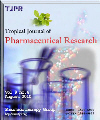
|
Tropical Journal of Pharmaceutical Research
Pharmacotherapy Group, Faculty of Pharmacy, University of Benin, Benin City, Nigeria
ISSN: 1596-5996
EISSN: 1596-5996
Vol. 16, No. 3, 2017, pp. 597-604
|
 Bioline Code: pr17077
Bioline Code: pr17077
Full paper language: English
Document type: Research Article
Document available free of charge
|
|
|
Tropical Journal of Pharmaceutical Research, Vol. 16, No. 3, 2017, pp. 597-604
| en |
Phytochemical screening, cytotoxicity and acute toxicity of Annona vepretorum  Mart (Annonaceae) leaf extracts Mart (Annonaceae) leaf extracts
Silva, Mariana G e; Oliveira, Ana P de; Araújo, Camila de S; Lavor, Érica M de; Silva, Juliane C; Mendes, Rosemairy L; Pessoa, Cláudia do Ó; Costa, Marcília P & Almeida, Jackson R G da S
Abstract
Purpose: To investigate the phytochemistry, cytotoxicity and acute toxicity of leaf extracts from Annona
vepretorum.
Methods: The crude extracts were obtained by maceration with hexane and methanol. The crude
methanol extract was suspended in a 3:7 (v/v) mixture of methanol (MeOH) and water (H2O) and
partitioned with hexane, chloroform (CHCl3) and ethyl acetate (AcOEt) in ascending order of polarity to
obtain the respective extracts. In the investigation of phytochemical profile, the extracts were evaluated
on thin layer chromatography (TLC) plates of silica gel. Cytotoxicity was tested using 3-(4,5-dimethyl-2-thiazolyl)-2,5-diphenyl-2H-tetrazolium bromide (MTT) and (3-(4,5-dimethylthiazol-2-yl)-5-(3-carboxymethoxyphenyl)-2-(4-sulfophenyl)-2H-tetrazolium) (MTS) assays against tumor cell lines, viz,
HCT-116 (colon), SF-295 (brain), HL-60 (leukemic) and Sarcoma-180. Acute toxicity study was
performed by administration of a single oral dose of 2 g/kg body weight of the extracts to mice and the
animals were observed for 14 days.
Results: Phytochemical screening results showed that A. vepretorum extracts contain alkaloids,
flavonoids and terpenes. Methanol and chloroform extracts exhibited high cytotoxic activity against
HCT-116, HL-60 and Sarcoma-180. Moreover, the extracts displayed low toxicity in mice, as no deaths
and pronounced toxic effects were observed.
Conclusion: A. vepretorum contains a variety of secondary metabolites which may confer on this
species high cytotoxic activity. In addition, the oral administration of the extracts produced low toxicity in
mice.
Keywords
Annonaceae; Annona vepretorum; Phytochemistry; Tumor cell lines; Acute toxicity
|
| |
© Copyright 2017 - Pharmacotherapy Group, Faculty of Pharmacy, University of Benin, Benin City, 300001 Nigeria.
Alternative site location: http://www.tjpr.org
|
|
